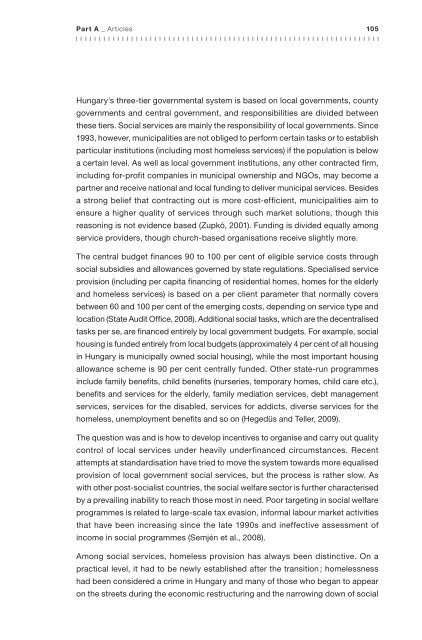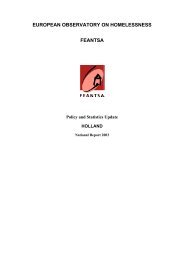Part A - Feantsa - Horus
Part A - Feantsa - Horus
Part A - Feantsa - Horus
You also want an ePaper? Increase the reach of your titles
YUMPU automatically turns print PDFs into web optimized ePapers that Google loves.
<strong>Part</strong> A _ Articles<br />
105<br />
Hungary’s three-tier governmental system is based on local governments, county<br />
governments and central government, and responsibilities are divided between<br />
these tiers. Social services are mainly the responsibility of local governments. Since<br />
1993, however, municipalities are not obliged to perform certain tasks or to establish<br />
particular institutions (including most homeless services) if the population is below<br />
a certain level. As well as local government institutions, any other contracted firm,<br />
including for-profit companies in municipal ownership and NGOs, may become a<br />
partner and receive national and local funding to deliver municipal services. Besides<br />
a strong belief that contracting out is more cost-efficient, municipalities aim to<br />
ensure a higher quality of services through such market solutions, though this<br />
reasoning is not evidence based (Zupkó, 2001). Funding is divided equally among<br />
service providers, though church-based organisations receive slightly more.<br />
The central budget finances 90 to 100 per cent of eligible service costs through<br />
social subsidies and allowances governed by state regulations. Specialised service<br />
provision (including per capita financing of residential homes, homes for the elderly<br />
and homeless services) is based on a per client parameter that normally covers<br />
between 60 and 100 per cent of the emerging costs, depending on service type and<br />
location (State Audit Office, 2008). Additional social tasks, which are the decentralised<br />
tasks per se, are financed entirely by local government budgets. For example, social<br />
housing is funded entirely from local budgets (approximately 4 per cent of all housing<br />
in Hungary is municipally owned social housing), while the most important housing<br />
allowance scheme is 90 per cent centrally funded. Other state-run programmes<br />
include family benefits, child benefits (nurseries, temporary homes, child care etc.),<br />
benefits and services for the elderly, family mediation services, debt management<br />
services, services for the disabled, services for addicts, diverse services for the<br />
homeless, unemployment benefits and so on (Hegedüs and Teller, 2009).<br />
The question was and is how to develop incentives to organise and carry out quality<br />
control of local services under heavily underfinanced circumstances. Recent<br />
attempts at standardisation have tried to move the system towards more equalised<br />
provision of local government social services, but the process is rather slow. As<br />
with other post-socialist countries, the social welfare sector is further characterised<br />
by a prevailing inability to reach those most in need. Poor targeting in social welfare<br />
programmes is related to large-scale tax evasion, informal labour market activities<br />
that have been increasing since the late 1990s and ineffective assessment of<br />
income in social programmes (Semjén et al., 2008).<br />
Among social services, homeless provision has always been distinctive. On a<br />
practical level, it had to be newly established after the transition ; homelessness<br />
had been considered a crime in Hungary and many of those who began to appear<br />
on the streets during the economic restructuring and the narrowing down of social




